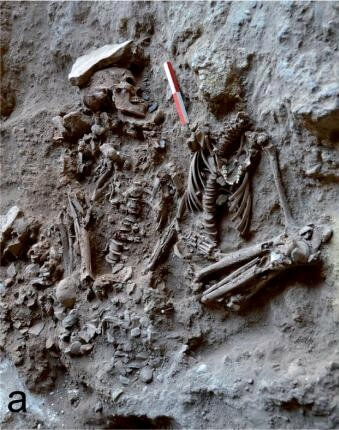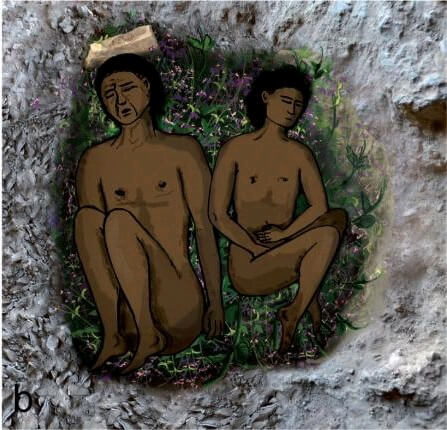A group of researchers from a number of universities in Israel and around the world, led by Prof. Danny Nadel from the University of Haifa, discovered in Merat Rakfat additional evidence of the lives of the first people who left the nomadic life and moved to permanent settlements

The first evidence of the use of a bed of flowers in funerals, dating back to 13,700 years ago, was discovered in the Rakfat cave in Carmel during excavations led by researchers from the University of Haifa. In four different graves from the Natufian period, 13,800 to 11,700 years old, dozens of sage plants and other species of plants from the sedge family were found under human skeletons.
"This is another 13,700-year-old testimony that our ancestors, the Netufs, had burial rites similar to ours today," says Prof. Danny Nadel from the University of Haifa, who led the excavations.
The Natufs who lived 15 years ago and up to 11,500 years ago were the first in the world to abandon the nomadic lifestyle and settled in permanent settlements, the infrastructure of which they created in stone. They were also among the first to establish cemeteries - demarcated areas where they buried members of their community for generations. The cemeteries were usually located in the first room of the cave or on terraces located under the caves. This is in contrast to previous cultures that used to bury their dead (if at all) randomly. Mount Carmel was one of the most important and populated areas in the Natufian settlement system. The sites in it have been studied by Haifa University researchers for decades.
A Natufian cemetery containing 29 skeletons of babies, children and adults was discovered in Rakfat Cave. Most of them were buried alone, although there were some double burials where two bodies were placed together in the same pit.
In four graves, the researchers found remains of flowers in a thin layer of mud that was applied as plaster inside the grave. Before burying the bodies, the Natopim prepared a carpet of green and flowering plants inside the grave.
In most cases, these are plants with square stems, which is common in the lipaceae family. In one case, flower stalks of a Yehuda sage plant were found, one of the three species of sage growing near the cave today. This led the researchers to assume that the burial was held in the spring and therefore they could use fragrant and colorful flowers. Rakfat Cave is among the first examples of tombs combined with green plants and flowers.

According to the researchers, the appearance of flower beds was not limited to adults, and the graves of children and adolescents were also covered with flowers. Since the mud surfaces did not include remains of objects made of stone and bones despite the presence of thousands of such items inside the cave and filling the graves, the researchers speculate that the green covering was thick and continuous and covered the entire bottom of the grave and its sides and thus prevented the objects from leaving a mark on the moist mud surfaces.
The researchers also found remains of Natufian sculptors who carved the rock in the cemetery, indicating that the graves were specially prepared to suit the needs. The Natufim also sculpted a variety of craters and cups near the tombs and on the exposed rocks on the terrace below the cave. The graves were dated using radioactive carbon. Samples from three different skeletons were dated at ages 13,700-11,700 years.
"
The Natopim lived in a time when many changes took place - a time when the population density increased and the struggle for territory, water and food sources grew. The establishment of the cemeteries and the unique burial rites reflect the complexity of Natufian society. Cooperative burial sites and the development of burial rites had to strengthen the sense of solidarity among community members and their feelings of unity vis-a-vis other groups" concludes Prof. Nadel.
: The project was led by researchers from the Zinman Institute of Archeology at the University of Haifa, and researchers from the Hebrew University of Jerusalem, the Weizmann Institute, the Max Planck Institute in Germany, the Center for Scientific Research in Paris and the Department of Anthropology at the University of Texas at Austin also participated in it. The researchers' findings were published in the journal PNAS.
The research project at Rakfat Cave has been ongoing since 2004, and is funded by a grant from National Geographic. Additional funding was provided by the Wenner-Gren and CARE foundations, Rakfat Cave is located within the Carmel National Park near the settlement of Elikim on the eastern side of Carmel, and the excavations are carried out under the license of the Antiquities Authority. Students from the Department of Archeology at the University of Haifa also participated in the excavations and the subsequent laboratory tests.
- to the notice of the researchers
- A video in which Prof. Mina Evron from the University of Haifa explains about Natufian culture
- Rakfat Cave - Wikipedia
More about the Natufian culture on the science website:

4 תגובות
Awesome, really interesting article
Or bury the man so he can accompany the woman.
In such an early period, women had a much more central role than their role in the patriarchal world. Man saw woman as an image of the Creator who creates life. According to the different methodologies around the world, man worshiped goddesses who bring life. And all mythologies have the same guidelines.
The goddess lives forever
She needs the death of the man (God) in order to fertilize her and create a new life.
In wandering for 2 minutes I could not find a more extensive source.
http://public.wsu.edu/~delahoyd/mythology/goddess.html
Is the buried couple a "love story" or did they also bury the poor woman so that she would accompany her husband on his last journey?
Just food for thought.
Shabbat Shalom